
EGX Rezzed - Highlights Part 1
I spent three (very) long days at EGX Rezzed this weekend, and now want to tell you about a few games that got me pretty hyped. Shall we begin?
Deceit
Deceit was a playable demo for a horror version of Garry’s Mod: Murder, where your group starts as balding men in boxer shorts in the basement of an asylum. The idea is to reach the top of the asylum and escape, but of the nine players, three are tasked with stopping that happening. These are the infected and they look like everyone else until the lights go out, when they can turn into terrifying monsters hell bent on killing the innocents.

Not something you'd want to meet in a dark alley
Everyone passively earns currency over time, and this money can be used to buy weapons, which are stashed on walls, or used to open doors to progress to the next level of the asylum. The higher the level, the better the weapons available, branching from a baseball bat on the ground floor to pistols and machetes on the top floor. In the round I played as the infected, I found that it was actually easier to just shoot people than it was to hunt them as the terrors of the night.
You can also pick up torches, of which there are two and have roughly a 30 second charge (so the developers told me, I didn’t actually see one in my two games of play), and a camera with a bright flash. The innocent can use these to stop the infected moving when in their monstrous forms, since they’re rather photophobic. Alternatively, the infected can grab them and make them entirely useless. This game, as the name suggests, is about lying and working out who’s lying. And I left the booth grinning ear to ear.
Esper 2
Esper 2 is the sequel to 2015s Esper, a virtual reality game that sees you learn about your newly found extrasensory abilities. The sequel, as one would imagine, is a more refined extension of those levels, with a new narrative and tighter mechanics.
You play as an ESPR agent with strong telekinetic abilities; the demo I played saw us trialing a training course for new ESPR recruits. In this course, I moved some spheres and some cubes into the appropriate containers, and then spent a little time throwing a sphere at some targets, all while being observed by a disembodied voice joking with me. I had to just put up with reading the subtitles since I was using a Samsung Gear VR to play which didn’t have any headphones, though I’ve been led to believe that Nick Frost and Lara Pulver are both in it.
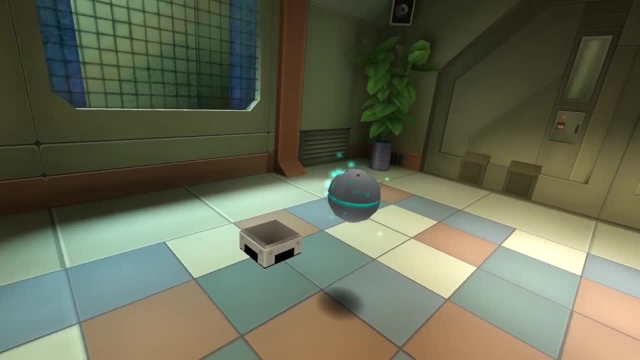
Ball, meet square hole
Using the Samsung Gear VR had the novelty of making me put my fingers to my head (well, the VR headset) to control the objects I was lifting. The picture quality was a little blurry but after a couple minutes I barely noticed, and I suspect on an Oculus it will be great. This is currently out for Gear VR, though if you can I’d suggest getting it on Oculus Rift just because the controls on the Gear VR were a little fiddly.
Californium
A 1960s drug trip gone very wrong, Californium puts you into the body of wannabe author Elvin Green, a man struggling to get very far with his writing and his relationships. After being left by his wife, Elvin’s TV starts talking to him, and the mechanic of the game begins: sigils start appearing around the world, and clicking on them makes a bubble appear around the area. These bubbles, we’re told, are glimpses into a parallel universe, and if we open up enough of them we can leave for this new one.
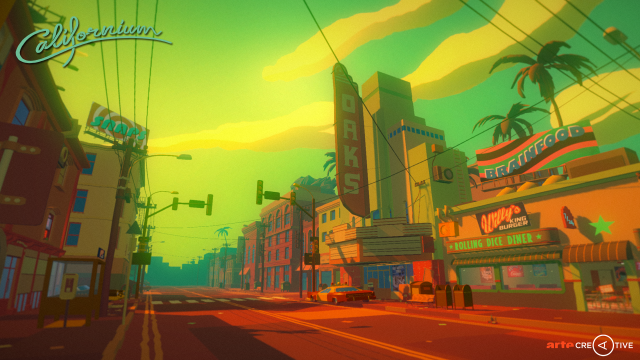
This was one of the less trippy images
This works out to make for a rather complex hidden object game, where the objects you’re looking for could be anywhere in the 3D space and like to only appear when you are in a certain position in the room. From the time I spent playing and the screenshots I’ve seen of later sections, the whole game is spent in the same street, with some elements staying the same and some changing vastly between universes.
The thing that really caught my eye with Californium was the art style: the street is a collection of low poly buildings, cars, signs and street decoration, and all the characters are single image flat 2D sprites that rotate to always face you. And it looks great, with huge detail on NPCs and very little detail in the world making it easy to see the distinct differences in each universe and still have an easy time finding the sigils.
Event[0]
Set aboard a 1970s spacecraft, Event[0] sees the player interact with an AI computer called Kaizen. Kaizen is not the most helpful computer system I’ve ever used, and despite being entirely text based shows minimal emotional responses. The game plays like a text adventure puzzle game that has the solutions in a 3D world that the text adventure lives in.
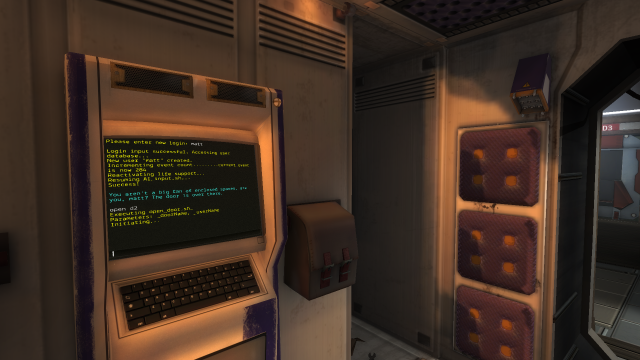
Kaizen is very good at opening doors, albeit briefly
I spoke to the writer of the game, Sergey Mohov, and it was very clear that Event[0] wears its inspirations on its sleeves, from the 2001:A Space Odyssey AI and ship design to the Event Horizon feel the whole game had. It was really great to talk to someone so obviously in love with science fiction, and from talking to him it was clear that he was funneling that love into Kaizen’s lines. This game is early in development, but I’m very excited to see it mature.
Blind
Most VR games are heavily focused in looking as good as they can. The same cannot be said for Blind, a VR game where you play as a woman who is blinded after a car crash. You awake in an unknown room, with a cane and the ability to echolocate, which is how you navigate around what you soon find is a mansion.
The game utilises a unique method for curing motion sickness: instead of allowing the player to move freely left and right, you use the bumpers to snap 30 degrees and move forwards and backwards with the analogue stick. You can still look around with the Oculus, but that only moves the character’s head, and while I’ve never experienced motion sickness in VR before, playing this felt very comfortable.
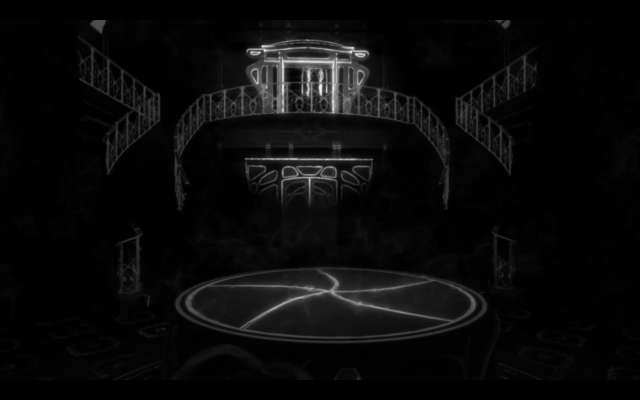
If only all tables contained loud clicking noises, maybe I wouldn't stub my toe
Blind is ultimately a puzzle game with horror elements, partly because you can’t see what your doing some of the time, and partly because the sound and story really make you feel what the character feels. The demo is focused on finding cogs for a central pillar that makes a nice ticking noise, which makes the pillar visible at all times. After finding the first cog, a door opens and through that door are three puzzles, each using a different mechanic and all being solvable without actually being able to see anything. Despite being a game about being blind, I’m very much looking forward to see where they take this idea, especially since despite being mostly black this was the best game design I saw on the floor.
Exo Exit
A surprising addition to this list, Exo Exit has only been in development for a couple months, and features an accurate topographical map of Mars. It’s a first person shooter set on the red planet at some point in the future, where aggressive robots and aliens roam the planetscape. The developers have done an amazing amount of work in the very short amount of time they've been working together and they have big plans for what they want to do next; I'm interested to see if they can pull it off.
Mekazoo
In a world where Sonic games are falling flat after trying to go too big, Mekazoo is coming in to bring back 2D momentum-based platforming. A great mix of Sonic and Little Big Planet 3, the Mekazoo demo allowed you to play as an Armadillo that has Sonic’s spin dash and a Frog whose tongue could be used as a grappling hook. You switch between these “mekanimals” at the press of a button, with the characters retaining the momentum from before the change.
The game is also visually stunning, with bright vibrant colours of nature and technology merging together. The enemies are all well designed and beautifully rendered, all resembling insects, and take inspiration from classic Sonic games as strange crosses between animals and robots.
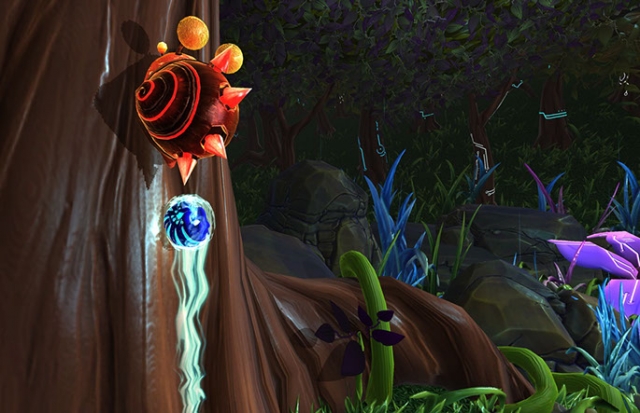
About to get the point very quickly
Something I didn’t notice until doing research for this article was how amazing the soundtrack is, mainly because Rezzed was louder and the headphones were not noise cancelling. Looking at the game’s website, you can actually hear some of the songs that “The Quiggles” have made for the game, and it’s a fantastic techno beat that I will gladly pay extra for when this game comes out.
Tidal
This was my second Rezzed, and a highlight for me from last year was the game jam presentation, which was the last of the developer sessions. The idea is that each team has eight hours to create a game based on a theme, and this years theme was flux. I only mention this because this game, Tidal, was built in eight hours, looks fantastic and is playable now. I won’t say any more, just go play this game and wonder how you make something like that in eight hours in Javascript.






COMMENTS
Dombalurina - 09:58pm, 14th April 2016
Mekazoo looks cracking!
TheSphericalCat - 10:05pm, 14th April 2016 Author
It felt really cool to play too, really smooth and punishing like a platformer should be